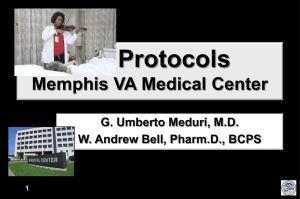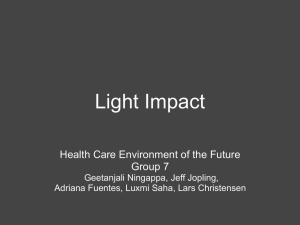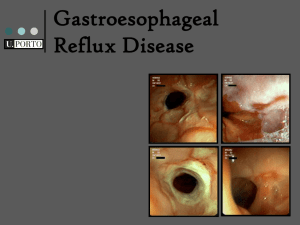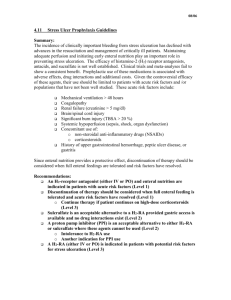Stress ulceration ppt
advertisement
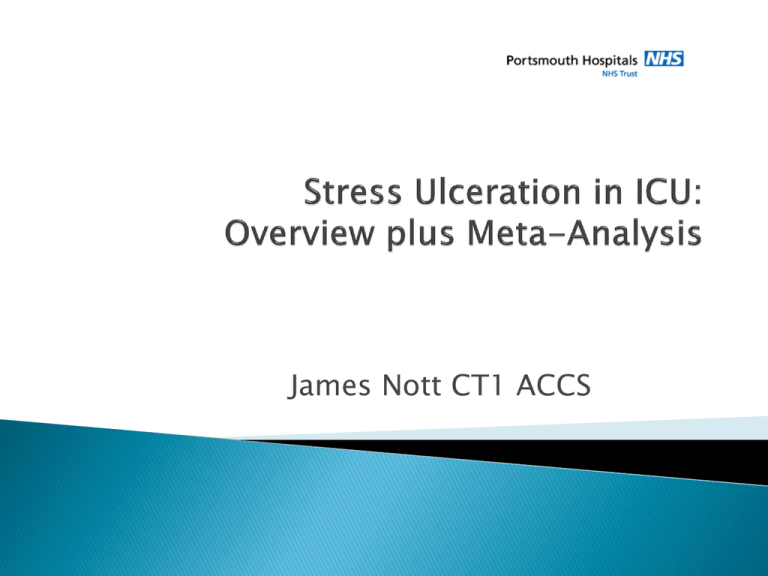
James Nott CT1 ACCS Epidemiology and Definition Pathophysiology of Stress ulcers Clinical presentation Risk factors Prophylaxis agents available – mechanisms Meta-Analysis: PPIs vs H2RA for stress ulcer prophylaxis in critically ill patients. Common ~ 1.5 – 8.5% GI bleeding in all ICU patients 15% - 25% of ICU patients not on prophylaxis 75% mucosal abnormalities of ICU patients <72hrs (major burn/cranial trauma) Ulcer: ‘Lesion of mucosal membrane accompanied by oedema and necrosis of surrounding tissue’ Loci: Stress ulcers - Fundus (Proximal) Peptic ulcers - antrum (Distal) / proximal duodenum Presentation range: Asymptomatic – Acute haemorrhage depending on depth of ulcer Imbalance: mucosal protection vs gastric pH Multi-factorial: Range depends on depth of ulcer Superficial: Asymptomatic Deep: Haemorrhage (Haematemesis /Melena) Intubated >48hrs OR 15.6 Coagulopathy OR 4.3 Additional risks identified: SHOCK Everyone! Sepsis Hepatic and Renal failure Multiple trauma Burns of >35% BSA Glucocorticoid therapy (3) Cook. DJ et al ’94 Pharmacological mechanisms: 1) Block acid secretion Competitive H2 antagonists (Ranitidine) Proton pump inhibitors (Omeprazole) 2) Neutralise stomach acid contents Antacids (Gaviscon) – Bicarbonate neutralises pH 3) Protecting stomach mucosa – nil buffering Sucraflate - polysaccharide + Aluminium hydroxide 4) Prostaglandin analogues Misoprostol – inhibit parietal cells to generate cAMP, thus reduce stomach acid secretion Nosocomial pneumonia (HAP/VAP) ↑ pH – Less hostile environment for bacteria Not so with Sucralfate (not affects pH) Ways to reduce risk: (Preventing aspiration) - Patient position – semirecumbant not supine - Mouth care – Chlorhexidine mouthwash/gel - Subglotic drainage - ? Residual gastric monitoring Aim: ‘Determine efficacy and safety of proton pump inhibitors verses H2 receptor antagonists for the prevention of upper GI bleeding in ICU’ Methodology: Search strategy – MEDLINE (1948-March 2012) EMBASE (1980-March 2012) independently ACPJC (1991-March 2012) Cochrane (central) database CINHAL. Two researchers extracted data Any disagreements resolved by discussion or consensus Types of study: - Randomised Control Trials (RCTs) Population: - ICU Adults (Medical and Surgical included) Intervention: - Control= H2RA Intervention=PPIs - para-enteral/enteral - regardless of dose, frequency and duration Primary outcomes: - clinically important GI bleed (?Meaning Hb drop/instability) - overt upper GI bleeding (coffee ground emesis, melena, fresh blood PR from UGI ) - Secondary outcomes: Nosocomial pneumonia (VAP/HAP) All-cause mortality ICU length of stay C. Diff infection - All trials assessed for risk, depending on domains: Low = risk low in ALL domains Unclear =risk is unclear in >1 domain High = risk is high in >1 domain Domains: Sequence Generation Allocation concealment Blinding Incomplete outcome data Selective reporting bias Free of other bias Plus – Overall risk of bias Data analysed using RevMan 5.1 model. Pooled: Dichotomous outcomes - RR 95% CI Continuous outcomes – Mean Methods of assessing heterogeneity (? Bias): Subgroup analysis – Size, Egger’s test /funnel plot to assess publication bias Primary objectives: 1) Clinically important bleeding (12 Trials n=1614) Significantly lower RR with PPIs vs H2RA: (RR 0.36 95% CI 0.19-0.68 p=0.002) 2) Overt Bleeding ( 14 Trials n= 1720) Significantly lower RR with PPIs vs H2RA: (RR 0.35; 95%CI 0.21-0.59 p<0.0001) 1) Nosocomial Pneumonia ( 8 Trials, n= 1100) No significant difference: RR 1.06 95% CI (0.731.52) p=0.76 2) Mortality ( 8 Trials n= 1196) No significant difference: RR 1.01 95% CI (0.831.24) p=0.91 3) ICU Length of stay ( 5 Trials n=555) No significant difference :CI (-2.20-1.13) p=53 4) Clostridium difficile infection No trials reported on C. Difficile infection ‘Significantly ↓ risk of both 10 outcomes with PPIs - Clinically important GI bleeding – RR 0.36 (0.19-0.68) - Overt UGI bleeding – RR 0.35 (0.21-0.59) ‘No significant ↓ risk of 20 outcomes with PPIs vs H2RA’ Nosocomial pneumonia – RR 1.06 (0.73-1.52) ICU mortality – RR 1.01 (0.83-1.24) ICU length of stay – RR 0.54 (-2.20-1.13) Primary outcomes (14 Trials): Low risk of bias – 3 Unclear – 5 High risk of bias – 6 (lack of blinding) Inflates benefit of PPIs Publication bias (Funnel plot): Larger trials (y axis) are more reliable – closer to mean RR (x axis) Inverted funnel shape Clinically important bleeding Overt bleeding outcome Definitions varied (Pneumonia) No randomisation of nutritional strategies Age of studies (1948) – ? relevance to today’s Accepts - ‘PPIs may lower risk of GI bleeding’ Welcomes further research: - Effect of early nutrition - Cost-benefit analysis - C. Diff infection NO! Meta-analysis does not show significant evidence that PPIs are better than H2RAs. Rantidine is cheap and as effective as PPIs for ulcer prophylaxis, so why change? Establish enteral nutrition important – no statistical evidence. Thank you, any questions!?! Cook.DJ, Stress ulcer prophylaxis. Best evidence synthesis Scand J Gastroenterol Supple 1995; 210:48 2) Stollman. N, Pathophysiology and prophylaxis of stress ulceration in ICU, Journal of critical care, vol 20, March 2005 3) Cook. DJ et al, risk factors for gastrointestinal bleeding in critical ill patients, Canadian Critical Care Trials Group. N Engl J Med 1994; 330:377 5) Marik P.E et al, Stress ulceration prophylaxis in the new millennium, meta-analysis. Critical Care Med 2010; 38:2222 1)



